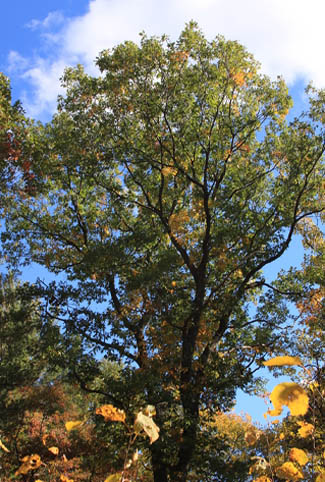 Quercus velutina
Quercus velutina
Native to the eastern United States the black oak is a short lived, medium to large tree with heights up to 80’ at maturity The leaves, like all red oak subspecies, have a bristled tip on the end of the lobe. Black oak leaves are alternate, simple, 5 to 9 inches long and have 5 to 7 irregular bristle tipped lobes. The lobes extend 2/3 to 7/8 of the way to the midrib of the leaf and have broad U-shaped or circular sinuses. The leaves are lustrous and dark green in color on the upper surface and paler or coppery below with scruffy pubescence and prominent tufts in the axils of the leaf veins. The bark is thick, nearly black in color and deeply furrowed with narrow scaly ridges; the inner bark is orange yellow in color. The acorns are 1/2 to 3/4 inch in length, red brown in color, and enclosed for 1/3 to 1/2 its length by the acorn cup. Red oak has shallower and more evenly lobed leaves, reddish inner bark, smaller buds, and a larger acorn enclosed less than 1/4 of its length by the acorn cup. The wood of black oak hard, heavy, and strong. The wood is usually of less value than red oak because the trees are often more open grown and tend to develop more branches. It is used in furniture, flooring, pallets, boxes, railroad ties, and mine timbers.



